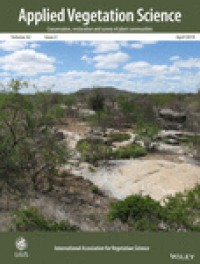Journal of Vegetation Science Q1 Unclaimed
Journal of Vegetation Science is a journal indexed in SJR in Plant Science and Ecology with an H index of 139. Journal with a Single blind Peer Review review system, and It has a price of 3167 €. It has an SJR impact factor of 1,068 and it has a best quartile of Q1. It is published in English. It has an SJR impact factor of 1,068.
Journal of Vegetation Science focuses its scope in these topics and keywords: species, spatial, trait, african, associations, awardswoody, bank, belowground, biomass, brazilian, ...
Type: Journal
Type of Copyright:
Languages: English
Open Access Policy:
Type of publications:
Publication frecuency: -


3167 €
Inmediate OANPD
Embargoed OA0 €
Non OAMetrics
1,068
SJR Impact factor139
H Index97
Total Docs (Last Year)289
Total Docs (3 years)6921
Total Refs856
Total Cites (3 years)283
Citable Docs (3 years)2.51
Cites/Doc (2 years)71.35
Ref/DocOther journals with similar parameters
Annual Review of Plant Biology Q1
Fungal Diversity Q1
Molecular Plant Q1
Nature Plants Q1
Annual Review of Phytopathology Q1
Compare this journals
Aims and Scope
Best articles by citations
Fine-grain pattern in Southern Cape plateau forests
View moreEdge detection in vegetation: Jornada revisited
View moreCompetition, invasion effects versus invasiveness and fuzzy classification
View moreFire and herbivory are not substitutable: evidence from regrowth patterns and changes in physical and chemical defences in Acacia seedlings
View moreObservation bias and its causes in botanical surveys on high-alpine summits
View morePhysiognomie development ofPseudotsugaforests in relation to initial structure and disturbance intensity
View moreSpecies richness of woody plants in the landscapes of Central Spain: the role of management disturbances, environment and non-stationarity
View moreFire and simulated herbivory have antagonistic effects on resistance of savanna grasslands to alien shrub invasion
View moreEcological ranges for the pH and NO3 of syntaxa: a new basis for the estimation of critical loads for acid and nitrogen deposition
View moreSmall-scale environmental heterogeneity and the analysis of species distributions along gradients
View moreSampling procedures and species estimation: testing the effectiveness of herbarium data against vegetation sampling in an oceanic island
View moreMapping gradients of community composition with nearest-neighbour imputation: extending plot data for landscape analysis
View moreBroad-scale patterns in smoke-responsive germination from the south-eastern Australian flora
View moreJuvenile-adult tree associations in a continental Mediterranean ecosystem: no evidence for sustained and general facilitation at increased aridity
View moreBiotic homogenization of urban floras by alien species: the role of species turnover and richness differences
View moreFiltering of plant functional traits is determined by environmental gradients and by past land use in a Mediterranean coastal marsh
View moreA vegetation zonation from saltmarsh to riverbank in New Zealand
View moreEuropean post-glacial forests: compositional changes in response to climatic change
View moreTowards a Prodrome of plant communities
View moreJoint control by rodent herbivory and nutrient availability of plant diversity in a salt marsh-salty steppe transition zone
View moreBetween- and within-species trait variability and the assembly of sapling communities in forest patches
View moreHistorical continuity and spatial connectivity ensure hedgerows are effective corridors for forest plants: Evidence from the species-time-area relationship
View moreRecognising fuzzy vegetation pattern: the spatial prediction of floristically defined fuzzy communities using species distribution modelling methods
View moreA structural analysis of three Irish wooded wetlands
View more
Comments